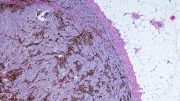
The researchers think that pyrvinium, a cheap drug created in the 1960s could be modified for use in the treatment of cancer.
Researchers from the University of Auckland have discovered that new combinations and formulations of older medicines are promising for the treatment of bowel cancer.
According to a team of University of Auckland scientists, the use of old drugs in new combinations is showing potential in the treatment of bowel cancer.
“While there have been advances in treatments for this disease in recent years, the development of new medicines is expensive and time-consuming,” lead researcher Professor Peter Shepherd says. “As a possible solution to this problem, our group has been investigating whether using old drugs in new ways could provide a faster and cheaper way of treating this disease.”
The researchers looked into several cancer drugs that would soon lose their patent protection. In their lab-based tests, scientists discovered that combining two of these drugs significantly increased the overall efficacy in treating bowel, or colorectal, cancer.
The groundwork for this study, according to Shepherd, has been laid by advancements in our understanding of how cancers function.
“In recent years, research has led to a rapid increase in our understanding of how colorectal cancer develops. In particular, some subtypes of the disease rely on the development of small blood vessels and on proteins called BRAF and beta-catenin. The research group identified existing drugs that target these and investigated the possibility that combining them could have powerful anti-cancer effects.”
Two older drugs have shown considerable promise in studies conducted at the University of Auckland. One is axitinib, an anticancer drug. The other is pyrvinium, a low-cost threadworm drug created in the 1960s that the researchers believe could be modified for use in cancer treatment. In one set of tests, the researchers discovered that combining axitinib with another older BRAF-targeting drug, vemurafenib, significantly increased its effectiveness. Axitinib works by reducing the growth of small blood vessels.
Both these drugs are used in other contexts to treat other types of cancer and will soon be off-patent and so the cost of using them in treatment will drop greatly, Shepherd says.
In a second set of studies, the group found evidence that pyrvinium, which targets beta-catenin, could also increase the efficacy of vemurafenib.
Dr. Khanh Tran who performed most of the experiments says, “This work suggests that existing drugs might be able to be repurposed to treat this type of cancer which could significantly reduce the cost of such therapy.”
Tran continues, “Since the drugs we used are already in use for other purposes, it makes it much easier to develop clinical trials to see how the findings of our studies will actually translate to improved outcomes for patients with this disease.”
Next, the researchers are planning a randomized, controlled clinical trial.
Reference: “Response to BRAF targeted therapy is enhanced by co-targeting VEGFRs or WNT/β-Catenin signaling in BRAF-mutant colorectal cancer models” by Khanh B. Tran, Sharada V. Kolekar, Qian Wang, Jen-Hsing Shih, Christina M. Buchanan, Sanjeev Deva and Peter R. Shepherd, 5 October 2022, Molecular Cancer Therapeutics.
DOI: 10.1158/1535-7163.MCT-21-0941
The HRC provided $1.2 million over three years for this research and the Gut Cancer Foundation supported this with an additional $150,000.








Be the first to comment on "A Low-Cost Drug From the 1960s Could Help Treat Colon Cancer"